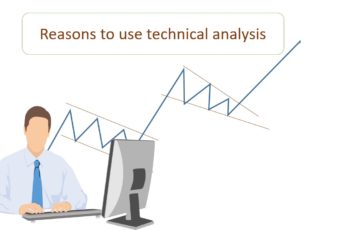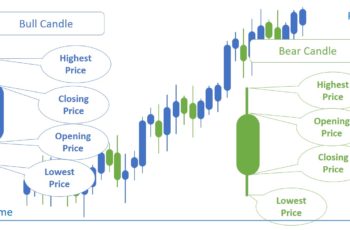What Is Intermarket Analysis?
Intermarket analysis is a technical analysis that looks at the relationship among multiple asset classes which is also known as cross-market analysis.
Traditionally, traders were looking at a single or an asset class to analyze the market. For example, Forex traders were looking for Forex pairs‘ charts, and commodity traders were looking at gold and oil charts.
However, it has changed. And investors need to track other asset classes that even they do not invest in because asset classes impact one another.
Intermarkt analysis studies how an asset class impacts the performance of another. Historically it shows that sectors and markets, mainly: bond, stock, commodity, and forex markets have a relationship together. It can be positive or negative.
However, the relationship among assets is not a must, and they can reverse. And often fundamentals are behind the continuation or reversal of the relationship.
Studying these relationships benefit investors because one asset class impacts directly or indirectly another asset class. For example, the steel market negatively impacts the auto market because this industry heavily uses steel.
How to Express the Correlation between Asset Classes?
Correlation indicates how the price of one asset class impacts another. Some of these correlations are stronger and more reliable, and some are weaker and transitory.
There are three scenarios in correlation.
- Positive: Two asset classes move in the same direction.
- Negative: Two asset classes move in the opposite direction.
- Random: Price movement of one market does not impact the other.
The strength of the relationship between two markets is expressed as a coefficient. It ranges between -100 to +100.
Here are what these coefficient numbers mean:
- -100: Two markets have complete negative relationships. If one market change direction, the other changes in the opposite instantly.
- -100 to -70: It indicates a strong negative relationship between the two asset classes.
- -70 to -30: The relationship between the two asset classes is negative. However, it is weak.
- -30 to +20: There is no relationship between the two markets.
- +100: Two markets have complete positive relationships. If one market change direction, the other does too instantly.
- +70 to +100: The relationship between the two asset classes is positively strong.
- +30 to +70: The relationship between the two asset classes is positive. However, it is weak.
Markets have correlations because they can substitute (replace) one another or complement (go together). They try to replace one another when they compete for capital. For example, investors buy gold when the USD does not perform well and buy USD when gold underperforms.
Markets go together when one of them needs the other. For example, the commodity market goes after the stock market because manufacturers purchase raw materials and need to perform well to buy raw materials.
Intermarket analysis studies the relationship between substitution and complementary markets. However, these relationships do not work well forever. Many other factors, such as economic indicators, natural disasters, and politics, can reverse the relationship.
For example, correlations in an economic crisis are weaker and depend on what caused the crisis. However, during expansions in the business cycle, correlations are more obvious.
Example of Correlation Between to Markets
The following chart at the bottom shows the correlation coefficient between Dow Jones Industrial Average and the Dollar Index.
For clear visualization, I chose the red area.
The indicator chart has three levels, 0 in the middle, +100 at the top of the indicator chart, and -100 at the bottom.
This chart shows that most of the time the correlation is negative. However, as mentioned earlier, the correlation change, which is why the correlation level appears in the positive area too.
Currency and Commodity Relationship in Intermarket Analysis
Currencies have a relationship with commodities. Commodities are raw materials that every manufacturing industry needs one or another commodity.
In addition to understanding how commodities influence the Forex market, it is crucial to know which commodities a country imports and exports.
The home currency of a commodity exporter profits when its price rises due to charging higher prices. Inversely, the domestic currency of importers loses due to paying higher prices.
Because not every country has sufficient commodities such as gold and oil, currencies perform differently.
So, this article explains the relationship between some currencies with commodities separately.
The United State Dollar Relationship with Commodities
The USD has an index. It is DXY.
So, this article compares the DXY with the Commodity Research Bureau (CRB) Index.
Because commodities are priced in the USD, they have a negative relationship. When the USD rises, the CRB falls, and vice versa.
In other words, when the commodities rise, holders of the USD pay a higher amount, and vice versa. Because traders trade commodities in the USD, they need to hold the USD as a reserve.
In the following chart, the blue color represents the DXY, and the orange the CRB Index.
Visually the chart shows that commodity and the USD have a negative relationship. And rarely, they have a positive relationship.
Moreover, the correlation coefficient indicator shows their relationship at the bottom of the chart.
The blue area shows that most of the time the relationship between the USD and commodity is negative.
However, sometimes the relationship can be positive. For example, when Donald Trump became president of the USA, he insisted on making the USA energy independent (labeled A area). As a result, the USA increased oil production, making the relationship positive. Another example is from mid-2021 to mid-2022, when inflation was increasing, and Russia invaded Ukraine too.
The Japanese Yen Relationship with Commodities
Japan lacks commodities, making it a major importer.
So, JPY has an inverse relationship with commodities.
When commodity prices increase, Japanese firms exchange a higher amount of Yen to buy commodities. It declines the forex reserve in Japan and makes the Yen cheaper.
In the following chart, I inserted the Japanese Yen Index (JXY) and the Commodity Research Bureau (CRB) Index.
The blue line represents the JXY and the orange the CRB.
This chart clearly shows that mostly when the the CRB rises, the JXY falls, and vice versa.
And the following shows how it looks like when insert the correlation coefficient technical indicator.
Australian Dollar and Commodity Relationship
Services are a major portion of the economy of Australia.
However, mining is the second in which Australia exports most of them. And we all know that exports and imports impact the currency exchange rate.
Australia’s main exporting commodities are minerals such as iron ore, coal, petroleum gas, and gold.
As a result, investors expect the AUD to get strengthen when these commodities rise.
The following chart shows the relationship between commodities (CRB) and the Australian dollar (AUD).
In this chart, the blue line is the AUD, and the orange represents the CRB. You see that both lines go in the same direction mostly.
And the correlation between the CRB and AUD is inserted at the bottom of the chart. You see positivity between them.
Canadian Dollar and Commodities
Canada exports commodities a lot.
According to oec.world, “the top exports of Canada are Crude Petroleum ($81.2B), Cars ($29B), Petroleum Gas ($15B), Gold ($14.3B), and Sawn Wood ($13.3B)”
So, commodities should impact the CAD directly.
The Canadian dollar depends on commodities more than the Australian dollar which you see in the following chart.
This chart shows the Canadian dollar in blue line and commodities in orange.
The correlation and coefficient indicator shows the dependency of the Canadian dollar on commodities.
Currency and Bond Relationship in Intermarket Analysis
The relationship between bonds and currency is negative.
In the following chart, the red line represnts bonds and the blue line dollar index (DXY).
The main reason behind this relationship is the interest rate. When the interest rate rises, so does depositors’ interest in cash because it can earn higher interest from the bank if deposited.
More importantly, the risk of owning cash is lower than bonds.
Thus, cash and bonds are substitutions and inversely related.
Bond and Commodities Relationship in Intermarket Analysis
Bonds and commodities have negative relationships.
Inflation and interest rate are the reasons behind the negative relationship between bonds and commodities.
Commodity price increases cause inflation. The central bank to combat inflation, raise the interest rate. And a hike in interest rates pushes the bond price lower.
On the other hand, when commodity price decreases, it lowers inflation. The central bank to prevent deflation raise interest rates. And a cut in interest rates increases bond price.
Notice that bond price and bond yield is different. The bond yield is the return on your investment in bonds. On the other hand, the bond price is the amount of money that you pay for it.
Moreover, bond price and bond yield have a negative correlation. When a bond price goes up, the yield decrease because new bonds that enter the market have a higher coupon rate.
So, this article talks about the bond price, not yield.
In the following chart, the blue line represents the CRB commodity index, and the red line Vanguard Total Bond Market ETF (BND).
The strength of correlation between them is not very strong because people do not depend on commodities alone. However, an inverse correlation exists.
In the following chart, I inserted the inflation rate (YOY) in the USA (green line) and the Treasury Interest Rate (black line) at the bottom of the chart.
You see that commodities started falling steeply in early 2020, and inflation started following. At the same time, bond prices started to fall slowly.
As inflation and commodities continued rising, bond prices continued falling.
In the early second quarter of 2022, the inflation began falling and months later, bond prices responded by going up.
Relationship between Bonds and Stocks in Intermarket Analysis
In my personal opinion, there is no trustworthy relationship between bond prices and stocks. Some traders claim that there is a positive and some even claim that there is a negative correlation between stocks and bond prices.
But, in the following I share charts that do not show a healthy relationship.
In the above chart, the blue line represents Dow Jones Industrial Average Index (Which is a stock index). And the red line represents the Vanguard Total Bond Market ETF which tracks the Bloomberg U.S. Aggregate Float Adjusted Index. The above does not show a reliable relationship because sometimes both move in the same direction and sometimes do not.
The following chart shows the correlation and coefficient of DJI and BND. And it does not show a clear relationship.
Differences between Traditional and Intermarket Analysis
Technical Intermarket analysis differs from traditional methods.
And the followings are some of them:
- Traditional technical analysis focuses on a single asset, such as a company’s stock and a currency. On the other hand, Intermarket analysis focuses on the whole market or a sector of a market, such as a commodity market, or auto market.
- Traditional technical analysis studies the chart patterns with the help of economic data. On the other hand, Intermarket analysis does not focus on price patterns such as rectangle patterns and candlestick patterns.
- Intermarket relationship changes, and even may reverse while traditional technical analysis methods do not change.


